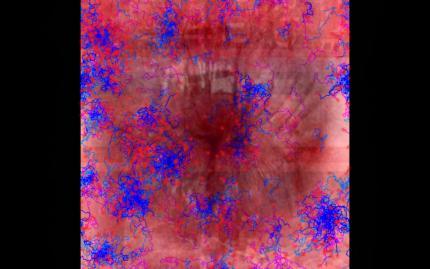 the dynamism Of becOming
the dynamism Of becOming
JOSEPH NECHVATAL nOise anusmOs by Robert C. Morgan @ Brooklyn Rail published here: http://www.brooklynrail.org/2012/06/artseen/joseph-nechvatal-noise-anusm...
Besides the anti-Oedipalist pairing of Deleuze with Guattari, the fatal actor Antonin Artaud, and the undaunted ex-Minister of Excess, Georges Bataille, there are few others who could escape the scathingly promiscuous beauty inscribed in the paintings and sensuous auditory and multimedia works of Joseph Nechvatal. This was recently shown at Galerie Richard in a suite of 10 new paintings (2011) by the artist, titled nOise anusmOs, in which he explores the primordial ecstasy of Bataille’s locus solus—the anal sphincter of the “viractual” (the artist’s word)—whereby harmonic intervals between the virtual and the actual find their correspondence within the visual field. Beginning in the mid-1980s, Nechvatal evolved a poetics of technology in working with dense overlays of information gathered from the web that he programmed robotically as paintings on canvas. At a later stage in the mid-1990s he developed a degenerative digital virus that would eat away at his design.
Virtually all of Nechvatal’s early mentors lived on the dark side, more or less (one might add the French Symbolists to the list above.) They have all indulged in a type of Dionysian abandon whereby guilt is disarmed through the absence of denial. An artist of Bohemian origins, he deems the dark side as being anathema to the feckless, lovelorn squanderers who landed on Plymouth Rock—corrupt officials steeped in a bogus religiosity, all figure and no ground. Nechvatal regards such callous machinations as a persistent aggravation that stands in the face of art. An artist refugee from the East Village era, he decided to take leave from the unthinkably tasteless mannerisms that had come to occupy the old neighborhood and made his way to Paris.
His defense was to immerse those linear maritime spoilers in the ecstasy of scatology by transmitting his “viral symphOny” that has now become a masterpiece. To hear this symphony of auditory elements loop through an unharnessed eschato-scatological chamber of noise may stir the emotional sensorium beyond reprieve, a psychedelic interstice if one is to be found amid the currency of overwrought calculations. “viral symphOny” was transmitted in New York on the occasion of nOise anusmOs as a counterpart to further enhance the effect of intelligent immersion, and thus, to defrock advanced art of its ritualized theoretical lassitude. These velvety dark black fields with brilliant red vectors immerse our sight and sound sensibilities in a scintillating cauldron of incestuous rare-bits. The paintings are filled with contorted calamities as the subtle lip between interior and exterior reveals a hint of aestheticized corporeal excess, which, in turn excites, if not detonates, an apotheosis of digestion. Such tantrums are beguiled by insolence. The unholy farthing reaps its vengeance by sustaining the omniscient cursor that moves unevenly throughout the incendiary birth of scented language.
What words do we have for Nechvatal’s porous subject matter? We may doubt our vision at every turn. The viral specimens move within a tightly contracted fleshy field—red against black—as tender vessels quicken within the smarting breadth of the sphincter. It is not surprising that one of the artist’s favorite works of art is the Mannerist Bernini’s “The Ecstasy of Saint Teresa” (1645 – 52). During Teresa’s levitation, the feeling of ecstasy swirled throughout her entrails as she passed beyond the reach of desire into a world removed from the Western duality of physical and spiritual existence, beyond pain and into a sustained, trembling delight. But the question lingers as to whether this is the goal of Nechvatal’s art. Is nOise anusmOs attempting to reach beyond the reachable through some form of aesthetic disjunction? Is there any social dimension that pertains to this solipsism of transcendence?
One might argue the following in Nechvatal’s defense: Having read the artist’s essays and books, including his recent and deftly important, Immersion Into Noise (University of Michigan: Open Humanities Press, 2011), there is clearly an attempt to transform social attitudes with regard to the persistent mediation that inhabits and plunders our historical consciousness in the present era of transition, as we struggle to find the equation between an ever-advancing technology and the quality of life. Some observers believe this quality is diminishing rapidly as “the future” advances, and is soon to be forgotten. Joseph Nechvatal takes a humanist approach in this regard, advocating that the new technology may enhance life, not through denial or begging-off from the inexorable speed of information layering (noise), but by immersing ourselves in this condition via the reintroduction of pleasure as something essential to life. I emphasis pleasure as in Eros -- not pornography, which Nechvatal would understand as a trap (trebuchet) of mind control, including economics and politics. Instead Eros is a combined mental and physical endorsement bereft of violence coming down to Earth again where the body retains its significance (and identity) as a source of knowledge. Through this evocation we may enter with one another into an agreement that the quality of life carries a certain ineffability and socially responsible dimension. In this way, we honor the rights of others to discern pleasure, not outside of ourselves, but through a clearer focus on the aesthetic dimensions of our own bodies as vulnerable, yet life-fulfilling organisms.